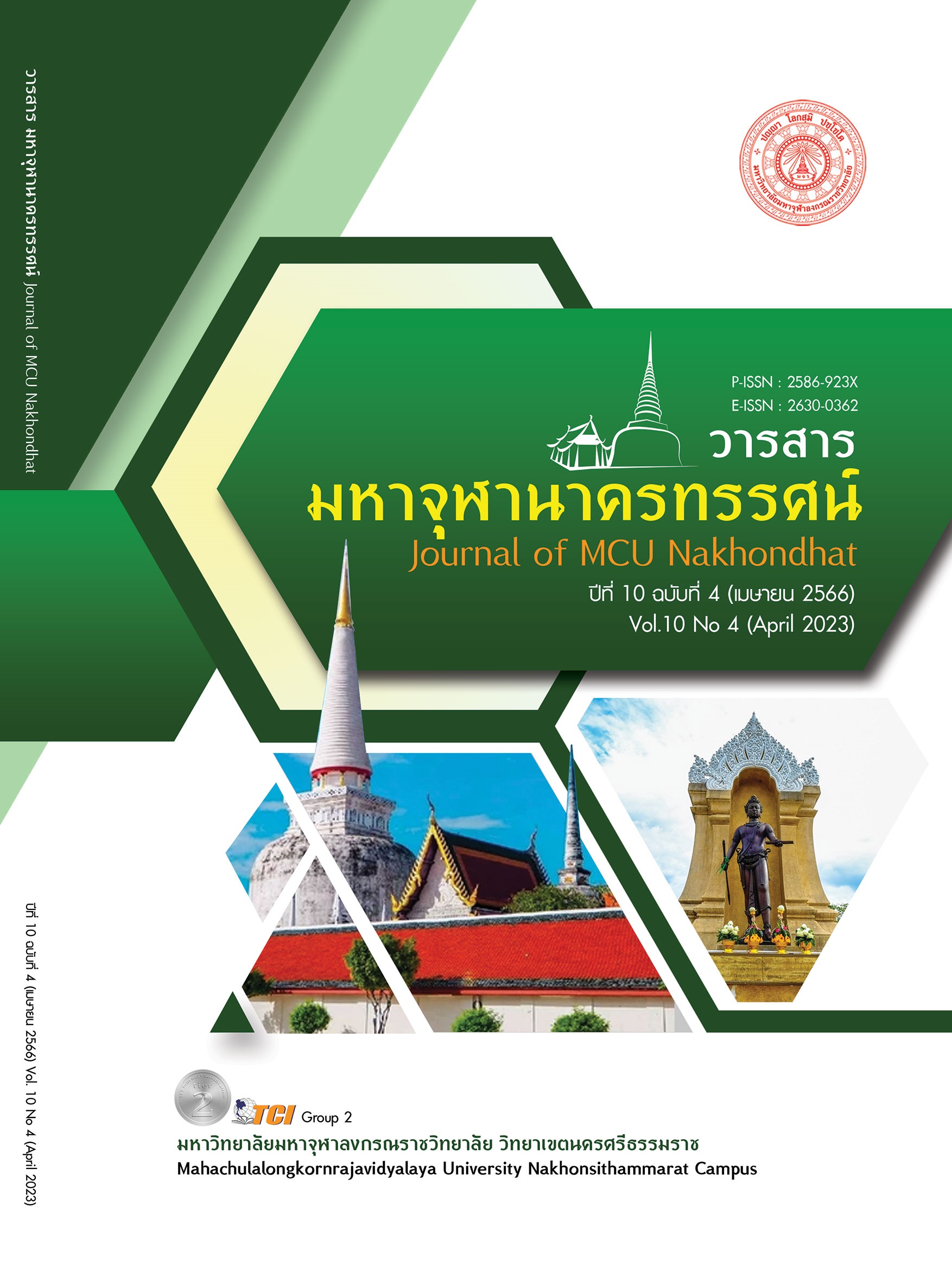THE EFFECTS OF TEAM ASSISTED INDIVIDUAL COOPERATIVE LEARNING SUPPLEMENTED WITH EXERCISES BOOK BASE ON NUMBER SENSE AND LEARNING LOG OF PRATHOMSUKSA 4 STUDENTS
Main Article Content
Abstract
The purposes of this research article were :1) to study mathematical achievement of Students 2) to compare mathematical achievement of Students on fraction between before and after learn 3) to study mathematical writing ability. The research was a one group pretest-postest design. The population were Prathomsuksa 4 students in 2/2021 academic year in normal curriculum classroom 8 classroom, 360 students. The sample group were Prathomsuksa 4 students in 2/ 2021 academic year 1 classrom, 46 students with mixed abilities which was obtained from cluster random sampling. The research Instrument included lesson plans, Exercises Book based on Number Sense, learning logs,a achievement test, a mathematical writing ability test. The trial was run alternately between even and odd numbers. Under the 2019 coronavirus situation lasted 4 hours a week, a total of hours, a total of 11 weeks. for all Mean, standard deviation, percentage were used for data analysis. A t-test for one sample and t-test for dependent samples were used for testing hypotheses. The findings of this research were as follows: 1) Students who study with team assisted individual cooperative learning supplemented with exercises book based on number sense and learning log that have mathematical achievement test score after learning were 27.61 or 76.70 percent. The students’ posttest score was not less than 75 percent. 2) Students who study with team assisted individual cooperative learning supplemented with exercises book based on number sense and learning log that have mathematical achievement test score were 13.22 or 36.70 percent and 27.61 or 76.70 percent respectively. The students’ mathematical achievement test score after the experiment was higher than that of the pretest. 3) Students who study with team assisted individual cooperative learning supplemented with exercises book based on number sense and learning log that have mathematical writing ability test score after learning were 27.04 or 75.12 percent.The students’ posttest score was not less than 75 percent.
Article Details

This work is licensed under a Creative Commons Attribution-NonCommercial-NoDerivatives 4.0 International License.
References
โรงเรียนอนุบาลอุดรธานี งานวัดและประเมินผล. (2564). รายงานผลสัมฤทธิ์ทางการเรียน โรงเรียนอนุบาลอุดรธานี ปีการศึกษา 2563. อุดรธานี: โรงเรียนอนุบาลอุดรธานี.
กำไลทอง วงศ์เจริญ. (2549). การเปรียบเทียบผลการเรียนวิชาคณิตศาสตร์ เรื่องเศษส่วนและทศนิยม ของนักเรียนชั้นประถมศึกษาปีที่ 6 ที่เรียนโดยใช้แบบฝึกพัฒนาความรู้สึกเชิงจำนวนกับการเรียนปกติ. ใน วิทยานิพนธ์การศึกษามหาบัณฑิต สาขาวิชาการวัดผลการศึกษา. มหาวิทยาลัยมหาสารคาม.
กิตตินันท์ แวงคำ. (2549). การเปรียบเทียบความรู้สึกเชิงจำนวน ผลสัมฤทธิ์ทางการเรียน และความพึงพอใจต่อการเรียนคณิตศาสตร์เรื่องเงินและการหารของนักเรียนชั้นประถมศึกษาปีที่ 2 ที่เรียนด้วยแผนการเรียนรู้โดยใช้แบบฝึกพัฒนาความรู้สึกเชิงจำนวน กับแผนการจัดการเรียนรู้การสอนปกติ. ใน วิทยานิพนธ์การศึกษามหาบัณฑิต สาขาวิชาการวัดผลการศึกษา. มหาวิทยาลัยมหาสารคาม.
ชนิสรา อริยะเดชช์. (2559). การพัฒนากิจกรรมการเรียนรู้โดยใช้รูปแบบการสอนแบบร่วมมือ เทคนิค TAIกลุ่มสาระการเรียนรู้คณิตศาสตร์ เรื่อง การบวก การลบและการคูณทศนิยมสำหรับชั้นประถมศึกษาปีที่ 5. วารสารมหาวิทยาลัยมหามกุฏราชวิทยาลัย วิทยาเขตร้อยเอ็ด, 1(7), 215-230.
ชาติชาย ม่วงปฐม. (2560). ทฤษฎีการเรียนการสอน. อุดรธานี: ศักดิ์ศรีอักษรการพิมพ์.
ณัฐดนัย เนียมทอง. (2561). คณิตศาสตร์กับกระบวนการการเรียนรู้ด้วยตนเอง. เรียกใช้เมื่อ 31 มกราคม 2564 จาก https://www.scimath.org/article-mathematics/item/8403-2018-06-01-02-56-04.
ปริสา วงศ์คำพระ. (2555). ผลการใช้รูปแบบการตั้งปัญหาเสริมด้วยกระบวนการแก้ปัญหาและการเขียนบันทึกการเรียนรู้ต่อความสามารถในการเก้ปัญหาและความสามารถในการเขียนทางคณิตศาสตร์ของนักเรียนชั้นมัธยมศึกษาปีที่ 6. ใน วิทยานิพนธ์ครุศาสตรมหาบัณฑิต สาขาวิชาหลักสูตรและการสอน. มหาวิทยาลัยราชภัฏอุดรธานี.
พิชิต ทองคำ. (2553). การจัดกิจกรรมการเรียนรู้กลุ่มสาระคณิตศาสตร์เรื่อง เศษส่วนที่เน้นความรู้สึกเชิงจำนวนโดยรูปแบบการสอนตามแนวคิดทฤษฎีคอนสตรัคติวิสต์ สำหรับชั้นมัธยมศึกษาปีที่ 1. ใน วิทยานิพนธ์ศึกษาศาสตรมหาบัณฑิต สาขาวิชาหลักสูตรและการสอน. มหาวิทยาลัยขอนแก่น.
ศิริพร มาวรรณา. (2546). ผลการใชทักษะการสื่อสารและการประเมินผลตามสภาพจริงที่มีต่อ ผลสัมฤทธิ์ทางการเรียน ของนักเรียนชั้นมัธยมศึกษาปีที่ 2 เรื่องการนําเสนอข้อมูล. ใน วิทยานิพนธ์การศึกษามหาบัณฑิต สาขาวิชาการสอนคณิตศาสตร์. มหาวิทยาลัยศรีนครินทรวิโรฒ.
สถาบันส่งเสริมการสอนวิทยาศาสตร์และเทคโนโลยี. (2545). เอกสารเสริมสำหรับครู กิจกรรมในห้องเรียนเพื่อพัฒนาความรู้สึกเชิงจำนวน. กรุงเทพมหานคร: เอส. พี. เอ็น. การพิมพ์ จำกัด.
สถาบันส่งเสริมการสอนวิทยาศาสตร์และเทคโนโลยี. (2553). เทคนิคการสอนแบบ Math league พัฒนาการเรียนรู้ได้อย่างไร. เรียกใช้เมื่อ 31 มกราคม 2564 จาก https://www.scimath.org/articlemathematics/item/1306-math-league.
สมฤดี แววไทสง. (2561). การพัฒนากิจกรรมการเรียนรู้วิชาคณิตศาสตร์ เรื่อง ความน่าจะเป็นโดยใช้รูปแบบการเรียนรู้แบบร่วมมือ เทคนิค TAI เพื่อเสริมทักษะในการแก้โจทย์ปัญหา ของนักเรียนชั้นมัธยมศึกษาปีที่ 3. ใน วิทยานิพนธ์การศึกษามหาบัณฑิต สาขาวิชาคณิตศาสตร์ศึกษา. มหาวิทยาลัยมหาสารคาม.
สำนักงานคณะกรรมการการศึกษาขั้นพื้นฐาน กระทรวงศึกษาธิการ. (2560). ตัวชี้วัดและสาระการเรียนรู้แกนกลาง กลุ่มสาระการเรียนรู้คณิตศาสตร์ (ฉบับปรับปรุง พ.ศ. 2560) ตามหลักสูตรแกนกลางการศึกษาขั้นพื้นฐาน พุทธศักราช 2551. กรุงเทพมหานคร: โรงพิมพ์ชุมนุมสหกรณ์การเกษตรแห่งประเทศไทย จำกัด.
อภิญญา ยะนะโชติ. (2559). การเปรียบเทียบความรู้สึกเชิงจำนวน การคิดวิเคราะห์ เจตคติต่อการจัดกิจกรรมการเรียนรู้และผลสัมฤทธิ์ทางการเรียนวิชาคณิตศาสตร์ ด้วยการจัดกิจกรรมการเรียนรู้ แบบซิปปาโดยการใช้สื่อประสมและเกมประกอบการสอนชั้นประถมศึกษาปีที่ 5. วารสารวัดผลการศึกษา มหาวิทยาลัยมหาสารคาม, 22(1), 384-395.
อมรรัตน์ เหล่าบุญมา. (2560). ผลการจัดกิจกรรมการเรียนรู้วิชาคณิตศาสตร์เรื่องเวลา โดยการจัดการเรียนการสอนด้วยเทคนิคกลุ่มเพื่อนช่วยเพื่อนเป็นรายบุคคล (TAI) ชั้นประถมศึกษาปีที่ 3. ใน วิทยานิพนธ์ศึกษาศาสตรมหาบัณฑิต สาขาวิชาคณิตศาสตร์ศึกษา. มหาวิทยาลัยมหาสารคาม.
Baker, M. J. (2019). Number sense and the effects on students’ mathematical success. In Master Theses in Education. Northwestern College.
Johnson, D. W., & Johnson, R.T. (2002). Meaningful assessment: A manageable and cooperative process. Boston: Allyn and Bacon.
Kastner, B. (1989). Number sense: The role of measurement applications. The Arithmetic Teacher, 36(6), 40-46.
Libertus, M. E. (2020). Effects of visual training of approximate number sense on auditory number sense and school math ability. Retrieved August 31 , 2020, from https://www.frontiersin.org/articles/10.3389/fpsyg. 2020.02085/full.
McIntosh, M. E., & Draper, R. J. (2001). Using learning logs in mathematics: Writing to learn. The Mathematics Teacher, 94(7), 554-555.
Rowan, T., & Morrow. (1993). Implementing K-8 curriculum and evaluation standards from the arithmetic teacher. MA: Ally and Bacon.
Slavin. (1988). Student team learning. Washington, D.C.: National Education Association. International Journal on Emerging Mathematics Education, 1(1), 41-52.
Zeleny, M. G. (2013). A mixed methods study of a journal-writing intervention for undergraduate students in a college mathematics course. In Degree of Doctor of Philosophy. Nebraska Lincoln University.


